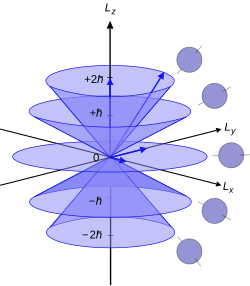Quantization axis
In quantum mechanics, the quantization axis is the spatial direction parallel to which the quantized component of the spin or angular momentum vector is selected. This establishes the basis on which state vectors are given.
Any spatial direction can be chosen as the quantization axis; As a rule, it makes sense to choose either an axis of symmetry of the system under consideration or the axis along which the spin or angular momentum is measured in the experiment.
Details
In quantum mechanics, spin and angular momentum are quantized, i.e. H. they can only assume certain values, namely integer or half-integer multiples of Planck's reduced quantum of action .
Since the three components of the spin vector can not be measured (or determined) at the same time (the associated observables do not commute with one another), the quantum-mechanical most precise description of the angular momentum state of a system is given by two quantum numbers :
- the amount of the angular momentum given by the angular momentum quantum number , and
- the value of a component of the angular momentum vector, precisely the component along the quantization axis : the magnetic quantum number , which in units of values can assume.
For a fixed amount , the angle of the angular momentum vector with the quantization axis can only assume discrete values (is quantized), which is why we also speak of directional quantization in this context . This was first observed in the Stern-Gerlach experiment , which can be used to demonstrate quantization along an applied magnetic field .
A choice of the quantization axis that matches the symmetry of the system often leads to a particularly simple form of the Hamilton operator of the system and to simpler selection rules for the possible transitions between the angular momentum eigenstates .
Examples
- For an electron in a homogeneous magnetic field in the -direction one chooses the -axis as the quantization axis of the spin and finds two possible eigenstates of the spin in the -direction:
- .
- For a polar molecule in an external electric field , it makes sense to choose the direction of the field as the quantization axis for the angular momentum eigenstates , since the angular momentum eigenstates are then also energy eigenstates (and thus stationary ).
- In a Bell experiment , correlation measurements are carried out on two entangled two-state systems (e.g. two spin-1/2 particles). For each of the two particles, a quantization axis is randomly selected (from a set of predetermined directions) along which the respective spin is measured. Under suitable conditions (and with sufficiently frequent repetition of the measurement) the violation of Bell's inequality can be proven.
literature
- Claude Cohen-Tannoudji , Bernard Diu, Franck Laloë, Joachim Streubel, Jochen Balla: Quantum Mechanics. Volume 1, chap. 6 . 3. Edition. Walter de Gruyter, Berlin / New York 2007, ISBN 3-11-019324-8 .
- Stern-Gerlach-Experiment , in: Walter Greulich (Ed.): Lexikon der Physik , 6 vols., Spektrum Verlag Heidelberg, 1998-2000. Also as a CD-ROM.
See also
References and comments
- ↑ In the following, angular momentum is used as a generic term for both quantities.
- ↑ a b J. J. Sakurai and SF Tuan, Modern Quantum Mechanics Addison-Wesley, 1994.
- ^ P. Atkins and R. Friedman Molecular Quantum Mechanics Oxford University Press, 2005.
- ↑ Lexicon of Physics Online (Spectrum of Science)









